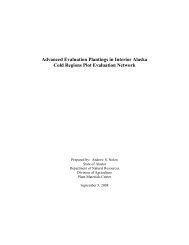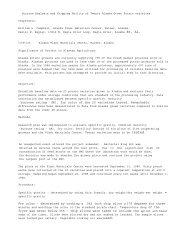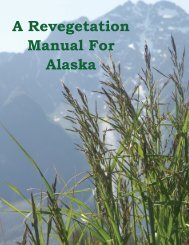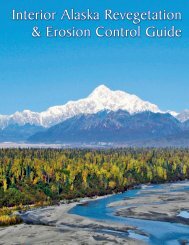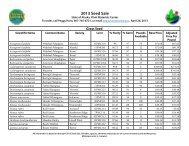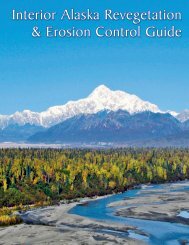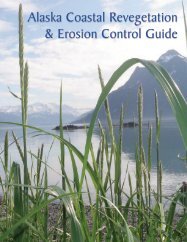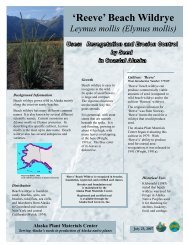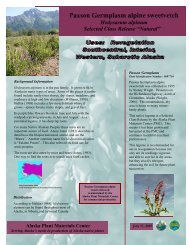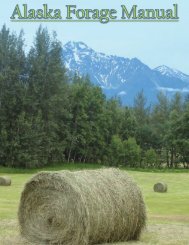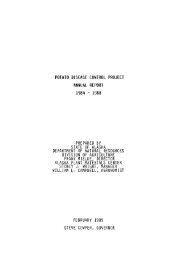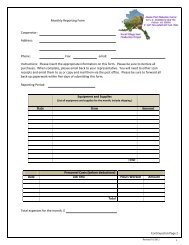Alaska Forage Manual - Alaska Plant Materials Center - State of ...
Alaska Forage Manual - Alaska Plant Materials Center - State of ...
Alaska Forage Manual - Alaska Plant Materials Center - State of ...
You also want an ePaper? Increase the reach of your titles
YUMPU automatically turns print PDFs into web optimized ePapers that Google loves.
Appendix B: Seed Specifications / Certification<br />
Seed Specifications<br />
Quality seed is critical to<br />
success. Specifying “certified”<br />
seed assures quality because<br />
the seed must meet certain standards<br />
for germination and purity;<br />
certification also provides some<br />
assurance <strong>of</strong> genetic quality.<br />
Some native seed species<br />
are not available as certified seed.<br />
Seed quality can still be ascertained by examining percent<br />
germination and percent purity; information that will be<br />
clearly labeled for any seed sold in <strong>Alaska</strong>. This labeling is<br />
required by 11 AAC, chapter 34: Seed Regulations.<br />
The true cost <strong>of</strong> seed can be determined by the<br />
Pure Live Seed calculation. To calculate Pure Live Seed<br />
(PLS), use the equation:<br />
The true price <strong>of</strong> seed, then, can be determined<br />
using the equation:<br />
These calculations can increase the accuracy <strong>of</strong><br />
bid comparisons. PLS price is a good method <strong>of</strong> comparing<br />
different seed lots at time <strong>of</strong> purchase. All seed<br />
sold or used in the state <strong>of</strong> <strong>Alaska</strong><br />
must also be free <strong>of</strong> noxious<br />
weeds, under 11 AAC 34.075. This<br />
is noted on seed tags, along with<br />
germination and purity.<br />
Seeding Rates<br />
When determining seeding<br />
rates, divide the desired seeding<br />
rate by the percent germination<br />
<strong>of</strong> the seed being used.<br />
For example, to achieve a 10 lbs/ acre seeding rate with<br />
seed having an 80% PLS (determined using the equation<br />
above), 10 lbs / .80 indicates that 12.5 lbs / acre should<br />
be used. If problems occur or questions arise regarding<br />
seed, call the <strong>Alaska</strong> <strong>Plant</strong> <strong>Materials</strong> <strong>Center</strong> at (907) 745-<br />
4469.<br />
Seed stored on site should be kept cool, dry, and<br />
in rodent-free areas. Remember seed is a living commodity.<br />
A bag may contain seed; however some percentage<br />
may be dead husks - the equivalent <strong>of</strong> cadavers. Always<br />
buy seed based on the PLS Calculation.<br />
<strong>Alaska</strong> Certified seed tags<br />
Pre-certified class seed tags<br />
Certified Seed<br />
The term “certified seed”<br />
can be used in two different situations.<br />
The <strong>of</strong>ficial use <strong>of</strong> the term<br />
Certified seed (with a capital C)<br />
is to describe seed that has been<br />
grown under the rules <strong>of</strong> the<br />
Seed Certification Program. Certified<br />
seed is the usual commercial<br />
category <strong>of</strong> seed. Its ancestry<br />
can be traced back to Registered<br />
Class or Foundation Class seed. In addition, Certified seed<br />
must meet various standards <strong>of</strong> purity and germination.<br />
These standards are a means <strong>of</strong> verifying authenticity <strong>of</strong> a<br />
seed source. All <strong>Alaska</strong> developed seed varieties or cultivars<br />
can be sold as either Certified or common.<br />
Seed can also be certified (without a capital C) to<br />
be free <strong>of</strong> weeds or as meeting a minimum germination<br />
standard (11 AAC 34.075). This has nothing to do with variety<br />
identification — it simply indicates the quality <strong>of</strong> the<br />
seed. In other words, the buyer knows quality, but has no<br />
assurance <strong>of</strong> type (other than species).<br />
Certified seed should be used when available.<br />
Seed produced in <strong>Alaska</strong> is easy to trace to its origin. It<br />
may be classified as common (uncertified) ‘Arctared’,<br />
but it is still ‘Arctared’. Minimum purities and germination<br />
should always be stated with orders. Common seed<br />
is a usable product and may be used to meet demands.<br />
Common seed should meet Certified<br />
standards with regard to<br />
germination and purity, although<br />
these standards may need to be<br />
relaxed to acquire sufficient material<br />
for a large job. Lower germination<br />
rates can be overcome<br />
by increasing the seeding rate.<br />
Lower purities, however, should<br />
be avoided, as weeds can become<br />
a problem.<br />
Other Certification Classes<br />
When purchasing seed, a buyer should be aware<br />
<strong>of</strong> the differences between certification classes. Many<br />
new sources <strong>of</strong> native seed are being developed in <strong>Alaska</strong>.<br />
Generally, these will not be sold as Certified seed.<br />
They may carry the following designations: ‘Source Identified’,<br />
‘Tested’, or ‘Selected’. These classes will be consistent<br />
with the certification standards <strong>of</strong> germination and<br />
purity, however the term ‘Certified seed’ will not apply.<br />
These classes are called ‘Pre-certified’ classes.



